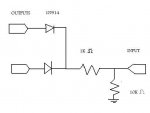I've been messing with serial communication for a while now...I have to have 2 outputs share an input line, making diode mixing necessary. I have some 1N914 diodes, and I was trying to find out how to orient them, and they seem to pass a logic signal regardless of which way I put it in the circuit. Huh?? Which end is the back stripe facing, and why am I getting a signal either way?
The input pin is grounded via a 10k resistor.
The input pin is grounded via a 10k resistor.

